#Advanced Battery Machines
Explore tagged Tumblr posts
Text
Experience the future of battery production through our detailed audio submission. Learn about the All-in-One Battery Machine that integrates Testing, Sorting, Welding, and Assembly into a seamless system. Discover how this innovation brings precision, scalability, and efficiency to modern manufacturing!
#All-in-One Battery Machine#Battery Testing and Sorting#Battery Assembly Solution#Battery Welding Machine#Streamlined Battery Manufacturing#Efficient Battery Production#Battery Manufacturing Technology#Advanced Battery Machines#Testing and Sorting for Batteries#Cutting-edge Battery Assembly
0 notes
Text
appleiphone
#Apple’s latest iPhone release has once again created a buzz in the tech world. Known for its innovation and premium quality#Apple has introduced several new features and enhancements in this iPhone series. From design upgrades to advanced performance capabilities#the new iPhhttps://pricewhiz.pk/one is making headlines. Let's dive into what makes this new iPhone stand out.#Design and Display:#The design of the new iPhone continues Apple’s legacy of combining elegance with durability. The latest model features a sleek glass and me#giving it a premium look and feel. The Super Retina XDR OLED display offers stunning visuals with improved brightness and contrast#ensuring a vibrant and immersive experience. Available in different sizes#the new iPhone caters to various user preferences#whether you prefer a compact phone or a larger display.#Processor and Performance:#At the heart of the new iPhone is the A16 Bionic chipset#Apple’s most powerful chip to date. This 6-core CPU and 5-core GPU deliver lightning-fast performance#making multitasking#gaming#and content creation smoother than ever. With its advanced machine learning capabilities#the iPhone adapts to your usage patterns#optimizing performance and enhancing overall efficiency.#Camera System:#Apple has always excelled in mobile photography#and the new iPhone takes it a step further. The upgraded 48-megapixel primary camera captures stunningly detailed photos#even in challenging lighting conditions. Low-light photography has seen significant improvements#allowing users to take clearer#sharper images at night. The iPhone also offers advanced video capabilities#including Cinematic Mode and Pro-level editing tools#making it ideal for both amateur and professional content creators.#Battery Life and Charging:#Battery life has always been a crucial factor for iPhone users#and Apple has made improvements in this area as well. The new iPhone promises all-day battery life#ensuring that you stay connected and productive without constantly worrying about recharging. Fast charging and wireless charging options m#Software and Security:
2 notes
·
View notes
Text
How to Create Stunning Graphics with Adobe Photoshop
Introduction
Adobe Photoshop is the preferred software for graphic designers, photographers, and digital artists worldwide. Its powerful tools and versatile features lead to the foundation of an essential application that one needs to create the best kind of graphics. Mastering Photoshop can improve your creative-level projects, whether you are a beginner or an experienced user. In this tutorial, we will walk you through the basics and advanced techniques so you can create stunning graphics with the help of Adobe Photoshop. Read to continue
#Technology#Science#business tech#Adobe cloud#Trends#Nvidia Drive#Analysis#Tech news#Science updates#Digital advancements#Tech trends#Science breakthroughs#Data analysis#Artificial intelligence#Machine learning#Ms office 365#Quantum computing#virtual lab#fashion institute of technology#solid state battery#elon musk internet#Cybersecurity#Internet of Things (IoT)#Big data#technology applications
0 notes
Text

My concepts for the development progress of an Iterators Puppet
-my ideas below
-Feasibility Study
[1]: First autonomous control module, any instruction to be given must be done manually through physical means (the keys), outputs were shown through the screen. A very primitive system, however, did its job proving the greater machine concept was achievable. While it does look like a lens above the monitor, this was a simple status gauge for benchmarking.
-Prototyping and Development
[2]: Now with the capability to wirelessly and audibly communicate to receive instructions and inputs. The system was no longer directly integrated into the facility, and resided on the first instance of an iterator's arm. This was considered a feat due to the complications with isolating the control module from the rest of the iterators components, while keeping processing power. A permanent connection/umbilical was needed to sustain life and function though.
To “talk” back, they were crafted with multidimensional projectors, the mobile arm allowing the angles and variance for this projection. Only later into development were advanced speakers installed for optimized understanding, however the extra computing power required to synthesize proper speech was found to strain the contained module, so this function had rare use in the end.
[3]: At this point there was a change in perspective in the project. What once were machines to simply compute and simulate, were now planned to be the home, caregiver, and providers. The further the project came to fruition the more religious importance was placed upon these “random gods”. From this stance not only did the puppets have to manage and control their facilities, they had to communicate with the people and priests. To represent benevolent beings who will bring their end and salvation. In this process iterators began to take a more humanoid shape, to better reflect their parents. Development was focused on compacting the puppet closer to the size of an ancient for this purpose. This stage was the first to incorporate a cloak/clothing into their design considerations, to further akin themselves in looks. The cloak would hide the iterators' engineered bodies and give a body to their silhouette.
[4]: As bioengineering and mechanics were rapidly progressing due to the void fluid revolution, this allowed plenty of margin for developing the outer design of the iterator puppets. This prototype was the first to incorporate limbs for the purpose of body language. This was another step in the drive to give a body to their random gods.
-Final Iterations
[5]: First generation iterators had the final redesign of puppet bodies. Far different from their first designs, they are fully humanoid. Their bodies are shaped to be organic and as full of life as they could at the time. Their center of sapience has fully settled within their body, as can be seen as their unconscious use of limbs without the direct intention for communication. This can also see how they manage their work, where many of the functions (which can be done with just an internal request) are operated through physical gestures of their limbs. Their puppet chambers also allow for full comprehensive projection, where many of their working monitors are displayed. It is seen how iterators prefer to utilize their traversal arm to transfer between the current working projection window.
These designs were hardy and nearly self-sufficient, only requiring minimal power from their umbilical to charge. (However was still limited in the terms of internal power production, for this first generation extensive batteries sufficed)
[6]: Later generation not only incorporated advanced bioengineering internally, but externally. While still a hardened shell, their body plates have been incorporated into the organics of the puppet, maintaining the protective requirements while barely leaving a trace of hinges or plates. This “soft” skin had drawbacks, such as reduced durability to the first generations, this was offset by the greatly enhanced repair speeds and capability this type of skin allowed.
Internal power generation was implemented into these late generation models. If the case arose, the Puppet could be disconnected from their umbilical and still be conscious from an undefined period of time. (However this would limit the operating capacity of the puppet when running self sufficiently) This greatly eased maintenance works, as the Puppet could still run the greater facility wirelessly while work was done on the chamber, arm or whatever as needed.
2K notes
·
View notes
Text
Black, White, & Time Travel
⭐️ Spoilers for Pokémon Black / White, along with some speculation.
Okay so. I might’ve mentioned Ikrit & I are casually replaying Black & White together. We got to Opelucid City & I’m wandering around chatting with NPC’s while Ikrit trains his team in the previous route.

I go over to this one house I’ve circled with the Youngster hanging outside. Upstairs I find this guy who was like “my father Bach made a machine that let him look into the future. I’m making one that looks into the past.”
…WHAT.

Ikrit runs over to that guy’s house in his game, & instead he finds a guy who’s like “I want to see my child Thyme’s future, so I’m making this machine”.
Both of them then just casually drops hints about the multiverse, saying they need a Pokémon who knows Charge from world where there’s another Opelucid City that looks “very old-timey” (Black) / “very futuristic” (White). So we catch & trade some Klinks, & give it to them. They both go over to their little laptop time machine thing & it activates.
For Ikrit (White) the man was like, “My precious Thyme is growing up as such a good kid!” His machine powers down, & he was like “What an experience! I can’t stop trembling! & even though I know the future, I guess my present time won’t change.” For me (Black), the man was like “Father! It’s me, Thyme!” He was like “I connected with the past…but I guess my present time won’t change.”
Both Bach & Thyme gave us a Cell Battery, & conclude to keep their heads in the present instead of worrying about the future & past. Bach (White) then tells little Thyme they were gonna go out & play while adult Thyme (Black) decides he was going to let go of his regrets & think positive.
—
So that happened. O_O
It could be that the past adult Thyme interacted with wasn’t his past, but was instead the other Thyme’s present - after all, he used a Pokémon from that other timeline. On that note, how did Bach & Thyme know about the other timeline? Why would they need that AU Pokémon, & how would they know? Since Thyme is a kid in White where there’s it’s more old-fashioned / natural in some places & an adult in Black where it’s more advanced / artificial (biggest examples being White Forest / Black City), is White in the past while Black is in the future?
Speaking of which, White Forest & Black City both show up as paintings in the Monochrome wallpaper in the BB League Club room, meaning either both exist, or they somehow know about both. For Ansy’s canon timeline, the Scarlet & Violet timelines converged - maybe something like that happened (which is kind of how I was treating it in the canon timeline anyways - I like White Forest way more than I do Black City, so in Ansy’s timeline it exists along with Black City 🌳🤍)
Lots of thoughts (clearly, lol). 💭
I found very little about this online, & since they weren’t in the house in BW2 (at least, when I checked in White 2 after doing this), looks like that’s all we’re gonna know about this on the canon side (until / unless the remakes &/or sequels we’re probably getting in Gen 10 adds anything).
TLDR: Black & White was hiding a time machine / multiversal little plot-line in Opelucid City this whole time.
#pokemon#black and white#unova#spoilers#opelucid city#pokemon npcs#speculation#theorizing#time travel#time machine#huh???
157 notes
·
View notes
Note
Some things that make me hopeful: That HIV/AIDS could be on the path to eradication via medical advancements, and that a lot of cancers are becoming "chronic treatable illness" rather than terminal illnesses. That vaccine development is as good as it is, and could be better. In short I find it inspiring that as harmful as our current healthcare system can be at some points, despite that, we're successfully fighting stuff that was often in history seen as inevitable or fate. Medical advances are slow but steady.
That for as bad as AI is in many ways, there are very promising developments with small, specialized machine learning models to serve as "second eyes" to assist humans in hyper-detailed tasks with bad outcomes if the human misses - e.g. detecting cancer in pathology samples, spotting tornado development in severe storms on radar. Accessibility is also getting a boost - text readers for Blind/visually impaired people and sound alerts/notifications for Deaf/hearing impaired people are improving, as is translation software for people who are not good natural language learners. That between solar, wind, nuclear, and even possibly the development of batteries that are less environmentally impacting/dangerous than Li-Ion, we may well start turning the tide on fossil fuels' damage to the planet. Walkable cities aren't a joke but an actual field of development and study, and there's actual work on public transit and moving away from dependence on cars in many places. On a social level, that, while, yes, it seems like the US and some other countries are going backwards for the time being - that it's very unlikely those advances will be forever lost worldwide. More people than ever are for LGBTQIA+ freedoms and rights, more people than ever are against at least the most overt and harmful displays of bigotry and racism and sexism even if they aren't perfect, etc. And this might be a bit controversial, but the decline of compulsory religious practice in much of the world. That you can choose your faith and how you display it, or choose to have no faith or anywhere in between would have seemed entirely impossible to people even 100 years ago in a lot of places and now, that's a given human right pretty much everywhere but the most restrictive theocracies and hyper-traditionalist families.
Hopeful things!! Thanks for sharing!!
204 notes
·
View notes
Text
Seeing Stars 2
Warnings: non/dubcon and other dark elements. My username actually says you never asked for any of this.
My warnings are not exhaustive but be aware this is a dark fic and may include potentially triggering topics. Please use your common sense when consuming content. I am not responsible for your decisions.
Character: Steve Rogers, Bucky Barnes
Summary: You struggle to be star struck by the world's most famous super soldiers. (grumpy!short!reader)
Note: Guess this is happening.
As usual, I would appreciate any and all feedback. I’m happy to once more go on this adventure with all of you! Thank you in advance for your comments and for reblogging ❤️

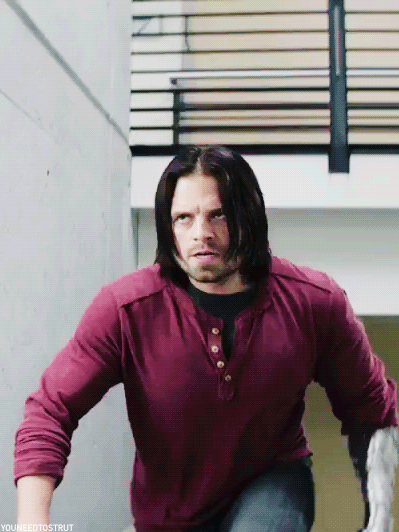
Your image in print makes you cringe again. If you keep doing that, you're going to form a few new wrinkles. It's hard to describe the expression on your face; somewhere between a gape and a grimace. Bonita doesn't seem to notice as she waves the signed photo in glee.
"Oh my god! Mo is going to hella jealous," she chimes.
You grumble. Another pair of thunder gods barge by and you stop short to keep from getting bonked by a foam hammer.
"They couldn't crop me out?" You wonder.
"Heyyyyy, no way. Then it'd only be me and cap," she whines. "You look fine."
She isn't looking at you. She's too obsessed with herself, perched perfectly in Steve Rogers' arms. You glower at your likeness and roll your eyes.
You shrug as if trying to wriggle free of the touch no longer there. It's there in the picture, that unwelcome embrace. It just happened so fast. You don't touch. You don't hug. Bonita gets on for her birthday and one for Christmas and outside of that, you have your bubble.
"My feet are killing me," you drone.
"You're not tapping our already, are you?" She chirps.
"No, but I could use a coffee. Maybe sit for a few."
"I don't want to miss the costume competition," she hums. "How about you come find me?"
"That works."
You'll agree to anything if it gets you a break from all this. You feel your battery flickering. You're at 12% socially and recharging will take days, if not weeks.
"I'll text if I get lost," you assure her.
You part and go in search of one of the vending machines you passed a few minutes ago. You're not outwardly sardonic, or you try not to be. When people describe you as deadpan, you're often surprised they pick up on that. You say as little as you can but some people take silence negatively.
You tap your card for the overpriced instant cappucino. The machine churns noisily and a cup drops down onto the tray. The brown espresso mix spits from the nozzle. Its aromatic even if you expect a watered down flavour.
You take the cup and blow over it. You keep away from the hordes of fandom devout. You wind along the wall and find a quiet hallway. You lean by the emergency exit and sip your coffee.
You close your eyes and sigh, tilting your head back as you let the coolness of the wall soothe you. You inhale as the thrum of the crowd drifts in. You don't want to go back.
There's some scuffing at the end of the hall. Your head snaps up and you stand straight, expecting a staff member to chase you out. Worse. It's one of them.
"Oh hey," the blond slows as he comes down the hall, stopping midway. "Um... didn't expect anyone back here."
You stare at Steve Rogers and take another drink, "just on my way out." You glance at the door to your left; 'Employees Only'. The placard beneath denotes a restroom. Makes sense, he can't piss with the peons.
"You got a photo," he says as you edge down the hall, keeping near the wall as you try not to get close.
"My friend did, yeah."
"Wait? You didn't get a copy? I can pull a few strings."
"No thanks," you stop a foot away from him, realising he's too big to squeeze by.
"You alright?" He asks, sounding genuinely concerned. Your forehead furrows but you stop the frown from reaching your lips, "I'm fine."
"These things give me a headache too," he says.
How presumptuous. Even if your head is feeling a bit dull.
"VIP is pretty nice. There's a lounge. I could get you and your friend some passes. Hear they got real coffee too," he gestures to your cup. "I don't know for sure, I don't get to enjoy it much."
"That's... too nice," you insist. "Excuse me, I gotta find my friend."
You motion past him but he only moves an inch, "need help?"
You look at him and shake your head, "I'll find her." You waggle your phone at him and turn, sidling by slowly. At last your free but at the cost of a few drops of coffee as it sloshes in your cup. It's bland. You toss it at the first bin. What a waste.
You find Bonita near the contest banner. She looks unimpressed as she pouts and crosses her arms. You near as a yawn threatens to break free.
"What's up?" You ask.
"Didn't qualify for the contest," she mopes. "So, guess I'll watch."
"Hm, there's a prize?"
"Just a gift card but still," she says.
"Ah, too bad."
"Well..." she looks around, "how about the raffle? The grand prize is a your of the Avengers compound or something."
You try not to show your disinterest. She better not invite you to that too. Ha, it's a long shot anyway. You'll humour her for a bit longer.
"Sure, why not."
You follow her over to the table. The staff at the table fill out the ballots for you using your ticket numbers. You give your information mindlessly, figuring there's enough people there that you'll forget you even bothered.
"That's so awesome," Bonita trills. "Can you imagine?"
You would hate it. You know. You like a museum tour or even a solitary stroll through the library but some good will act for good PR? You'll pass.
"I hope you win," you say to Bonita.
"Me too. I have so many questions!" She begins to ramble as you only half-listen.
As you walk along the booths, your eyes wander through the milling bodies. You squint as a head of golden hair bobs at the far end of the room and pauses. Even on your toes, you can't see enough to confirm your suspicions. What does it matter anyway? Good luck to the Cap finding his way back through these fanatics. You don't envy his lot, you hardly covet your own.
#steve rogers#bucky barnes#dark steve rogers#dark!bucky barnes#dark bucky barnes#dark!steve rogers#steve rogers x reader#bucky barnes x reader#series#drabble#seeing stars#marvel#mcu#captain america#winter soldier#avengers
217 notes
·
View notes
Text
Cleantech has an enshittification problem
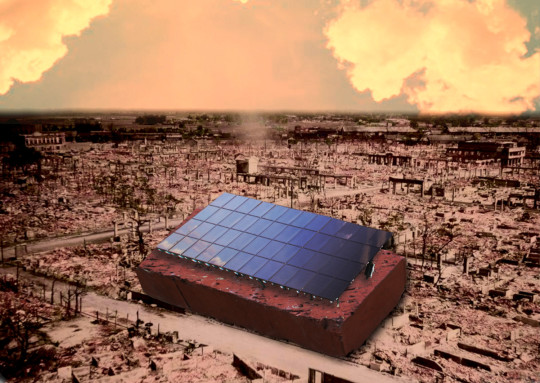
On July 14, I'm giving the closing keynote for the fifteenth HACKERS ON PLANET EARTH, in QUEENS, NY. Happy Bastille Day! On July 20, I'm appearing in CHICAGO at Exile in Bookville.

EVs won't save the planet. Ultimately, the material bill for billions of individual vehicles and the unavoidable geometry of more cars-more traffic-more roads-greater distances-more cars dictate that the future of our cities and planet requires public transit – lots of it.
But no matter how much public transit we install, there's always going to be some personal vehicles on the road, and not just bikes, ebikes and scooters. Between deliveries, accessibility, and stubbornly low-density regions, there's going to be a lot of cars, vans and trucks on the road for the foreseeable future, and these should be electric.
Beyond that irreducible minimum of personal vehicles, there's the fact that individuals can't install their own public transit system; in places that lack the political will or means to create working transit, EVs are a way for people to significantly reduce their personal emissions.
In policy circles, EV adoption is treated as a logistical and financial issue, so governments have focused on making EVs affordable and increasing the density of charging stations. As an EV owner, I can affirm that affordability and logistics were important concerns when we were shopping for a car.
But there's a third EV problem that is almost entirely off policy radar: enshittification.
An EV is a rolling computer in a fancy case with a squishy person inside of it. While this can sound scary, there are lots of cool implications for this. For example, your EV could download your local power company's tariff schedule and preferentially charge itself when the rates are lowest; they could also coordinate with the utility to reduce charging when loads are peaking. You can start them with your phone. Your repair technician can run extensive remote diagnostics on them and help you solve many problems from the road. New features can be delivered over the air.
That's just for starters, but there's so much more in the future. After all, the signal virtue of a digital computer is its flexibility. The only computer we know how to make is the Turing complete, universal, Von Neumann machine, which can run every valid program. If a feature is computationally tractable – from automated parallel parking to advanced collision prevention – it can run on a car.
The problem is that this digital flexibility presents a moral hazard to EV manufacturers. EVs are designed to make any kind of unauthorized, owner-selected modification into an IP rights violation ("IP" in this case is "any law that lets me control the conduct of my customers or competitors"):
https://locusmag.com/2020/09/cory-doctorow-ip/
EVs are also designed so that the manufacturer can unilaterally exert control over them or alter their operation. EVs – even more than conventional vehicles – are designed to be remotely killswitched in order to help manufacturers and dealers pressure people into paying their car notes on time:
https://pluralistic.net/2023/07/24/rent-to-pwn/#kitt-is-a-demon
Manufacturers can reach into your car and change how much of your battery you can access:
https://pluralistic.net/2023/07/28/edison-not-tesla/#demon-haunted-world
They can lock your car and have it send its location to a repo man, then greet him by blinking its lights, honking its horn, and pulling out of its parking space:
https://tiremeetsroad.com/2021/03/18/tesla-allegedly-remotely-unlocks-model-3-owners-car-uses-smart-summon-to-help-repo-agent/
And of course, they can detect when you've asked independent mechanic to service your car and then punish you by degrading its functionality:
https://www.repairerdrivennews.com/2024/06/26/two-of-eight-claims-in-tesla-anti-trust-lawsuit-will-move-forward/
This is "twiddling" – unilaterally and irreversibly altering the functionality of a product or service, secure in the knowledge that IP law will prevent anyone from twiddling back by restoring the gadget to a preferred configuration:
https://pluralistic.net/2023/02/19/twiddler/
The thing is, for an EV, twiddling is the best case scenario. As bad as it is for the company that made your EV to change how it works whenever they feel like picking your pocket, that's infinitely preferable to the manufacturer going bankrupt and bricking your car.
That's what just happened to owners of Fisker EVs, cars that cost $40-70k. Cars are long-term purchases. An EV should last 12-20 years, or even longer if you pay to swap the battery pack. Fisker was founded in 2016 and shipped its first Ocean SUV in 2023. The company is now bankrupt:
https://insideevs.com/news/723669/fisker-inc-bankruptcy-chapter-11-official/
Fisker called its vehicles "software-based cars" and they weren't kidding. Without continuous software updates and server access, those Fisker Ocean SUVs are turning into bricks. What's more, the company designed the car from the ground up to make any kind of independent service and support into a felony, by wrapping the whole thing in overlapping layers of IP. That means that no one can step in with a module that jailbreaks the Fisker and drops in an alternative firmware that will keep the fleet rolling.
This is the third EV risk – not just finance, not just charger infrastructure, but the possibility that any whizzy, cool new EV company will go bust and brick your $70k cleantech investment, irreversibly transforming your car into 5,500 lb worth of e-waste.
This confers a huge advantage onto the big automakers like VW, Kia, Ford, etc. Tesla gets a pass, too, because it achieved critical mass before people started to wise up to the risk of twiddling and bricking. If you're making a serious investment in a product you expect to use for 20 years, are you really gonna buy it from a two-year old startup with six months' capital in the bank?
The incumbency advantage here means that the big automakers won't have any reason to sink a lot of money into R&D, because they won't have to worry about hungry startups with cool new ideas eating their lunches. They can maintain the cozy cartel that has seen cars stagnate for decades, with the majority of "innovation" taking the form of shitty, extractive and ill-starred ideas like touchscreen controls and an accelerator pedal that you have to rent by the month:
https://www.theverge.com/2022/11/23/23474969/mercedes-car-subscription-faster-acceleration-feature-price
Put that way, it's clear that this isn't an EV problem, it's a cleantech problem. Cleantech has all the problems of EVs: it requires a large capital expenditure, it will be "smart," and it is expected to last for decades. That's rooftop solar, heat-pumps, smart thermostat sensor arrays, and home storage batteries.
And just as with EVs, policymakers have focused on infrastructure and affordability without paying any attention to the enshittification risks. Your rooftop solar will likely be controlled via a Solaredge box – a terrible technology that stops working if it can't reach the internet for a protracted period (that's right, your home solar stops working if the grid fails!).
I found this out the hard way during the covid lockdowns, when Solaredge terminated its 3G cellular contract and notified me that I would have to replace the modem in my system or it would stop working. This was at the height of the supply-chain crisis and there was a long waiting list for any replacement modems, with wifi cards (that used your home internet rather than a cellular connection) completely sold out for most of a year.
There are good reasons to connect rooftop solar arrays to the internet – it's not just so that Solaredge can enshittify my service. Solar arrays that coordinate with the grid can make it much easier and safer to manage a grid that was designed for centralized power production and is being retrofitted for distributed generation, one roof at a time.
But when the imperatives of extraction and efficiency go to war, extraction always wins. After all, the Solaredge system is already in place and solar installers are largely ignorant of, and indifferent to, the reasons that a homeowner might want to directly control and monitor their system via local controls that don't roundtrip through the cloud.
Somewhere in the hindbrain of any prospective solar purchaser is the experience with bricked and enshittified "smart" gadgets, and the knowledge that anything they buy from a cool startup with lots of great ideas for improving production, monitoring, and/or costs poses the risk of having your 20 year investment bricked after just a few years – and, thanks to the extractive imperative, no one will be able to step in and restore your ex-solar array to good working order.
I make the majority of my living from books, which means that my pay is very "lumpy" – I get large sums when I publish a book and very little in between. For many years, I've used these payments to make big purchases, rather than financing them over long periods where I can't predict my income. We've used my book payments to put in solar, then an induction stove, then a battery. We used one to buy out the lease on our EV. And just a month ago, we used the money from my upcoming Enshittification book to put in a heat pump (with enough left over to pay for a pair of long-overdue cataract surgeries, scheduled for the fall).
When we started shopping for heat pumps, it was clear that this was a very exciting sector. First of all, heat pumps are kind of magic, so efficient and effective it's almost surreal. But beyond the basic tech – which has been around since the late 1940s – there is a vast ferment of cool digital features coming from exciting and innovative startups.
By nature, I'm the kid of person who likes these digital features. I started out as a computer programmer, and while I haven't written production code since the previous millennium, I've been in and around the tech industry for my whole adult life. But when it came time to buy a heat-pump – an investment that I expected to last for 20 years or more – there was no way I was going to buy one of these cool new digitally enhanced pumps, no matter how much the reviewers loved them. Sure, they'd work well, but it's precisely because I'm so knowledgeable about high tech that I could see that they would fail very, very badly.
You may think EVs are bullshit, and they are – though there will always be room for some personal vehicles, and it's better for people in transit deserts to drive EVs than gas-guzzlers. You may think rooftop solar is a dead-end and be all-in on utility scale solar (I think we need both, especially given the grid-disrupting extreme climate events on our horizon). But there's still a wide range of cleantech – induction tops, heat pumps, smart thermostats – that are capital intensive, have a long duty cycle, and have good reasons to be digitized and networked.
Take home storage batteries: your utility can push its rate card to your battery every time they change their prices, and your battery can use that information to decide when to let your house tap into the grid, and when to switch over to powering your home with the solar you've stored up during the day. This is a very old and proven pattern in tech: the old Fidonet BBS network used a version of this, with each BBS timing its calls to other nodes to coincide with the cheapest long-distance rates, so that messages for distant systems could be passed on:
https://en.wikipedia.org/wiki/FidoNet
Cleantech is a very dynamic sector, even if its triumphs are largely unheralded. There's a quiet revolution underway in generation, storage and transmission of renewable power, and a complimentary revolution in power-consumption in vehicles and homes:
https://pluralistic.net/2024/06/12/s-curve/#anything-that-cant-go-on-forever-eventually-stops
But cleantech is too important to leave to the incumbents, who are addicted to enshittification and planned obsolescence. These giant, financialized firms lack the discipline and culture to make products that have the features – and cost savings – to make them appealing to the very wide range of buyers who must transition as soon as possible, for the sake of the very planet.
It's not enough for our policymakers to focus on financing and infrastructure barriers to cleantech adoption. We also need a policy-level response to enshittification.
Ideally, every cleantech device would be designed so that it was impossible to enshittify – which would also make it impossible to brick:
Based on free software (best), or with source code escrowed with a trustee who must release the code if the company enters administration (distant second-best);
All patents in a royalty-free patent-pool (best); or in a trust that will release them into a royalty-free pool if the company enters administration (distant second-best);
No parts-pairing or other DRM permitted (best); or with parts-pairing utilities available to all parties on a reasonable and non-discriminatory basis (distant second-best);
All diagnostic and error codes in the public domain, with all codes in the clear within the device (best); or with decoding utilities available on demand to all comers on a reasonable and non-discriminatory basis (distant second-best).
There's an obvious business objection to this: it will reduce investment in innovative cleantech because investors will perceive these restrictions as limits on the expected profits of their portfolio companies. It's true: these measures are designed to prevent rent-extraction and other enshittificatory practices by cleantech companies, and to the extent that investors are counting on enshittification rents, this might prevent them from investing.
But that has to be balanced against the way that a general prohibition on enshittificatory practices will inspire consumer confidence in innovative and novel cleantech products, because buyers will know that their investments will be protected over the whole expected lifespan of the product, even if the startup goes bust (nearly every startup goes bust). These measures mean that a company with a cool product will have a much larger customer-base to sell to. Those additional sales more than offset the loss of expected revenue from cheating and screwing your customers by twiddling them to death.
There's also an obvious legal objection to this: creating these policies will require a huge amount of action from Congress and the executive branch, a whole whack of new rules and laws to make them happen, and each will attract court-challenges.
That's also true, though it shouldn't stop us from trying to get legal reforms. As a matter of public policy, it's terrible and fucked up that companies can enshittify the things we buy and leave us with no remedy.
However, we don't have to wait for legal reform to make this work. We can take a shortcut with procurement – the things governments buy with public money. The feds, the states and localities buy a lot of cleantech: for public facilities, for public housing, for public use. Prudent public policy dictates that governments should refuse to buy any tech unless it is designed to be enshittification-resistant.
This is an old and honorable tradition in policymaking. Lincoln insisted that the rifles he bought for the Union Army come with interoperable tooling and ammo, for obvious reasons. No one wants to be the Commander in Chief who shows up on the battlefield and says, "Sorry, boys, war's postponed, our sole supplier decided to stop making ammunition."
By creating a market for enshittification-proof cleantech, governments can ensure that the public always has the option of buying an EV that can't be bricked even if the maker goes bust, a heat-pump whose digital features can be replaced or maintained by a third party of your choosing, a solar controller that coordinates with the grid in ways that serve their owners – not the manufacturers' shareholders.
We're going to have to change a lot to survive the coming years. Sure, there's a lot of scary ways that things can go wrong, but there's plenty about our world that should change, and plenty of ways those changes could be for the better. It's not enough for policymakers to focus on ensuring that we can afford to buy whatever badly thought-through, extractive tech the biggest companies want to foist on us – we also need a focus on making cleantech fit for purpose, truly smart, reliable and resilient.

Support me this summer on the Clarion Write-A-Thon and help raise money for the Clarion Science Fiction and Fantasy Writers' Workshop!

If you'd like an essay-formatted version of this post to read or share, here's a link to it on pluralistic.net, my surveillance-free, ad-free, tracker-free blog:
https://pluralistic.net/2024/06/26/unplanned-obsolescence/#better-micetraps

Image: 臺灣古寫真上色 (modified) https://commons.wikimedia.org/wiki/File:Raid_on_Kagi_City_1945.jpg
Grendelkhan (modified) https://commons.wikimedia.org/wiki/File:Ground_mounted_solar_panels.gk.jpg
CC BY-SA 4.0 https://creativecommons.org/licenses/by-sa/4.0/deed.en
#pluralistic#procurement#cleantech#evs#solar#solarpunk#policy#copyfight#copyright#felony contempt of business model#floss#free software#open source#oss#dmca 1201#interoperability#adversarial interoperability#solarization#electrification#enshittification#innovation#incumbency#climate#climate emergency
433 notes
·
View notes
Text
Rainy Day Dropoff

How some of our favorite JJK men would handle a little downpour and getting your toddler off to daycare.
A/N: The bike in question is in the header image, a standard mamachari. The kid seat sits over the front forks, they're really easy to ride and control, especially if you have a battery-powered one. I love mine. I also deeply abhor morning drop-off when it's raining. Pickup is fun because puddles and playtime!
WC: 844

The morning drop-off, a routine you and your toddler have down to a science, a well-oiled machine. You leave the house at the same time every day, say “bye bye, papa!” and the two of you toddle over to your mamachari. It’s a nice ride through the neighborhood over to daycare. Peaceful, quiet, a lovely time to teach your child about what they see and listen to their adorable attempts to repeat your words.
But this morning, it’s pouring rain with no signs of stopping. You steel yourself for the wet trip there and back, knowing that despite a rain poncho, a hat, and hood, you always come back giving your best drenched cat impression.
Ah, but your dear husband has heard your grumbling and decided to handle the drop off today.
Nanami Kento - Kento wakes up first and sees the weather. Immediately, he adjusted his morning routine to get both him and your toddler out the door and into both daycare and work successfully and on time. He doesn’t often do drop-offs, but he knows how much you hate going out in the rain. Pulling out his waterproof hiking and rain boots, he sits by the door, and you watch little hands grab the tops of his boots as he tugs them on with exaggerated effort. You help both put their raincoats and helmets on (most adults eschew a helmet, but not your husband!) and see them out the door.
Kento quickly gets everyone situated on the bike under the parking space cover and sets off cautiously. Once at daycare, he sits your toddler on the spacious porch and runs back to zip up the rain cover on the bike seat, ensuring it stays dry for pickup in the afternoon. Luckily, your usually energetic toddler stays put under the overhang instead of bolting off. Dropoff is quick, everyone stays dry, and no accidental wet feet after taking off their boots and storing for the afternoon return trip.
Suguru Geto - Suguru checked the weather in advance and set his alarm slightly early to make sure he could get the bike moved over to a dry spot closer to the front door of the apartment building. Once everyone is out the door, he grabs an extra umbrella to provide extra coverage. Not a drop on either him nor your toddler as he gets them situated in their seat and the rain cover zipped down. He makes sure to draw a little flower in the fog forming on the plastic window. Hitting every puddle just to pull laughs from your toddler along the short journey.
Pulling out the extra umbrella at daycare, again a quick and dry transfer into the daycare. He repeats the routine at pickup and even brings a set of rain pants to let the little one splash around and remain dry before returning home.
Satoru Gojo - Satoru sees the rain and calls Ijichi to drive you and your toddler into daycare. On a normal, dry day he doesn’t mind you biking the kids in. Even though everyone else arrives by car, you insisted that you use your mamachari. It’s a gentle exercise, the view is stunning (especially in the spring while riding along the sakura-lined river), and the two of you strike up adorable conversations about what you each see. But in this weather, you easily relent and hop in the car.
Hiromi Higuruma - Your dear Hiromi has the best of intentions, both in boots, but oops the jacket is forgotten because it’s warm outside. The bike is parked under cover, sure, but there’s a hole in the roof drainage right next to the bike, exactly in the spot he needs to stand in to put your toddler in their seat. While the ride is quick, his poncho hood flies off his head immediately, the wind buffeting you both. And despite his best efforts, he hit a few puddles along the way. At least someone finds them fun.
Once he arrives, he quickly grabs the bag of clothes and daily supplies and reaches into the seat, picking up the almost-2-year-old. As soon as he places them standing on the ground he hears-
“Papa, shoe! Papa, shoe!”
“Shit, ah fuck, I mean, sorry!” failing to control his language knowing that that little toddler brain will absolutely pick up on those words and use it later. He looks down to see a little one-footed hop and a missing boot. Ah ha, it was in the bike seat. Quickly, but not fast enough, he manages to stuff the little, wet, foot back into the boot.
He picks up the bag and toddler and jogs over to the front patio at daycare. Shedding his poncho and punching in the door code, he sits your toddler down to take off boots and socks. And then he notices how wet the front of your toddler’s clothes is. Right, wet poncho. After handing them off to the staff, he just gives a lopsided smile as they look over the wet patches on the toddler, running to see their friends.
#jen の stories#jjk#jjk fanfic#jjk fluff#nanami kento#geto suguru#gojo satoru#higuruma hiromi#jjk nanami#jjk suguru#jjk satoru#jjk hiromi
238 notes
·
View notes
Text
youtube
Discover the revolutionary All-in-One Battery Machine that integrates Testing, Sorting, Welding, and Assembly into one streamlined solution. Built for precision, scalability, and efficiency, this machine is shaping the future of battery manufacturing.
#All-in-One Battery Machine#Battery Testing and Sorting#Battery Assembly Solution#Battery Welding Machine#Streamlined Battery Manufacturing#Efficient Battery Production#Battery Manufacturing Technology#Advanced Battery Machines#Testing and Sorting for Batteries#Cutting-edge Battery Assembly#Youtube
0 notes
Text
Normandy trip : day 4, part 2 !!
Easy Company edition, part II/III
Still in the D-Day Museum in Utah Beach, a temporary exhibition was entirely dedicated to the archaeological excavations of the Brecourt Manor, and how they help understand the assault.
It opens with what the assault is, who did it, and how it was made famous.


The helmet is signed by Kirk Acevedo, Robin Laing, Ross Mccall, Frank John Hughes, Rick Gomez, James Madio, George Calil, Douglas Spain, Peter O'Meara, Peter Youngblood Hills and Philip Barantini (unfortunately not all signatures were visible 😭)
The Franc bill is signed by James Madio and Kirk Acevedo !


A small area displayed this set up, with the book signed by many veterans.
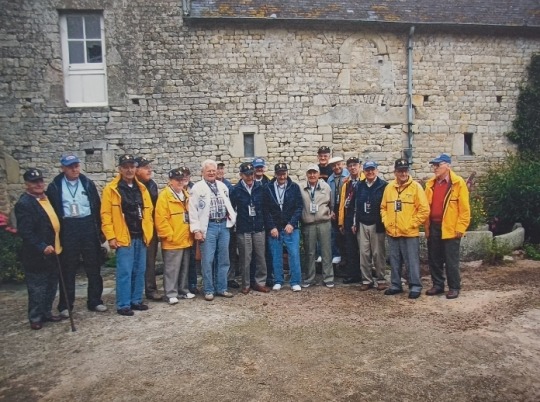
and this was taken at the inauguration of the Brecourt memorial
The pictures then were either the various finds the archaeologists made, or papers and drawings made by Winters to prepare the assault on the Brecourt Manor. Some drawings also displayed show how, according to finds, Winters' drawing and Ambrose's book, the assault must've taken place.
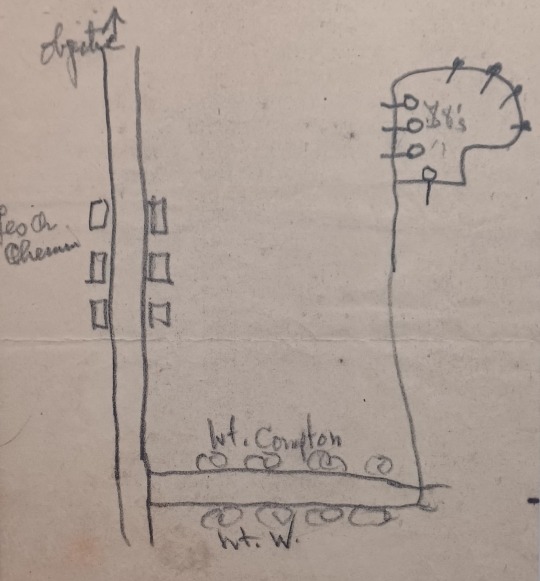
This drawing is from Dick Winters' dairy, page 4. It shows the hamlet of Grand-Chemin and the Battery of Brecourt.

The diagram is here replaced on an aerial picture taken in May 1944. We can here see how he imagined the space !
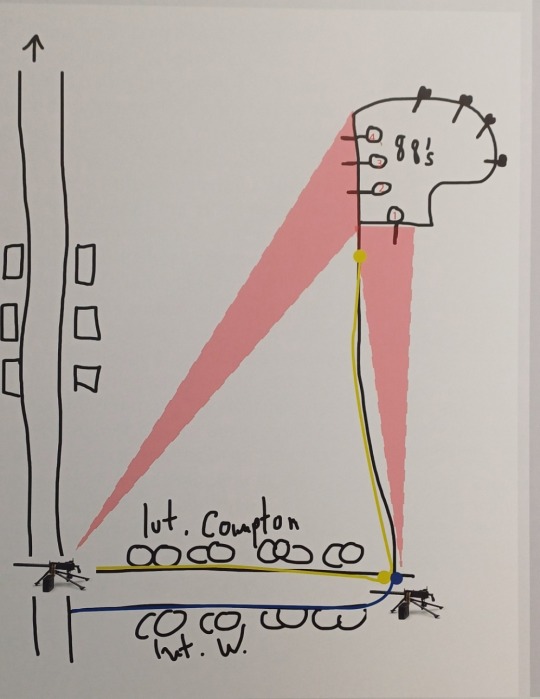
Winters' group is in blue, Compton's in yellow. After placing a first machine gun at the base of its axis of progression, Winters and Compton advanced along 2 different hedges, then regroup a first time. Winters placed a second machine gun there. Compton was sent forward, covered by the machine gun and by the Winters detachment.
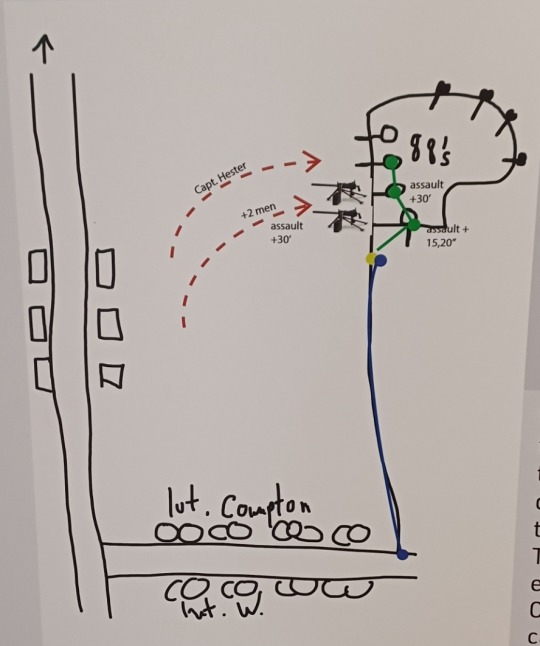
Winters' group then joins Compton's. The two simultaneously assault a first cannon position, which is captured after a time that Winters estimates at 15-20 seconds. Then, covering each other, they advance to cannon 2. Once taken, Winters takes a break time to receive new ammunition and bring his machine guns closer. Two men arrive for backup. The break lasts about 30 minutes, at the end of which the group assaults the gun 3. There, Winters is joined by Captain Hester who brings him TNT to destroy the three guns already captured.

The assault group was joined by 4 or 5 men led by Ron Speirs. It was this group that assaulted the fourth gun. Once it was taken and destroyed, the unit retreated to its original bases !
#Normandy with moonysashes#band of brothers#hbo war#hbo bob#dick winters#ronald speirs#Brecourt#joe liebgott#joe toye#shifty powers#frank john hughes#frank perconte#bill guarnere#babe heffron#carwood lipton
32 notes
·
View notes
Text
How to Optimize Your Workflow with Task Management Software
Introduction
The world has become too fast-moving; hence, the demand for organization and productivity is higher than ever. From multiple tasks at hand to meeting deadlines, the pressure is always there to make things easier. Task management software provides a powerful solution for this issue. This guide will walk you through optimizing your workflow with task management software to bring about efficiency and effectiveness in both personal and professional aspects of life. Read to continue...
#Technology#Science#business tech#Adobe cloud#Trends#Nvidia Drive#Analysis#Tech news#Science updates#Digital advancements#Tech trends#Science breakthroughs#Data analysis#Artificial intelligence#Machine learning#Ms office 365#Quantum computing#virtual lab#fashion institute of technology#solid state battery#elon musk internet#Cybersecurity#Internet of Things (IoT)#Big data#technology applications
0 notes
Text
100 Inventions by Women
LIFE-SAVING/MEDICAL/GLOBAL IMPACT:
Artificial Heart Valve – Nina Starr Braunwald
Stem Cell Isolation from Bone Marrow – Ann Tsukamoto
Chemotherapy Drug Research – Gertrude Elion
Antifungal Antibiotic (Nystatin) – Rachel Fuller Brown & Elizabeth Lee Hazen
Apgar Score (Newborn Health Assessment) – Virginia Apgar
Vaccination Distribution Logistics – Sara Josephine Baker
Hand-Held Laser Device for Cataracts – Patricia Bath
Portable Life-Saving Heart Monitor – Dr. Helen Brooke Taussig
Medical Mask Design – Ellen Ochoa
Dental Filling Techniques – Lucy Hobbs Taylor
Radiation Treatment Research – Cécile Vogt
Ultrasound Advancements – Denise Grey
Biodegradable Sanitary Pads – Arunachalam Muruganantham (with women-led testing teams)
First Computer Algorithm – Ada Lovelace
COBOL Programming Language – Grace Hopper
Computer Compiler – Grace Hopper
FORTRAN/FORUMAC Language Development – Jean E. Sammet
Caller ID and Call Waiting – Dr. Shirley Ann Jackson
Voice over Internet Protocol (VoIP) – Marian Croak
Wireless Transmission Technology – Hedy Lamarr
Polaroid Camera Chemistry / Digital Projection Optics – Edith Clarke
Jet Propulsion Systems Work – Yvonne Brill
Infrared Astronomy Tech – Nancy Roman
Astronomical Data Archiving – Henrietta Swan Leavitt
Nuclear Physics Research Tools – Chien-Shiung Wu
Protein Folding Software – Eleanor Dodson
Global Network for Earthquake Detection – Inge Lehmann
Earthquake Resistant Structures – Edith Clarke
Water Distillation Device – Maria Telkes
Portable Water Filtration Devices – Theresa Dankovich
Solar Thermal Storage System – Maria Telkes
Solar-Powered House – Mária Telkes
Solar Cooker Advancements – Barbara Kerr
Microbiome Research – Maria Gloria Dominguez-Bello
Marine Navigation System – Ida Hyde
Anti-Malarial Drug Work – Tu Youyou
Digital Payment Security Algorithms – Radia Perlman
Wireless Transmitters for Aviation – Harriet Quimby
Contributions to Touchscreen Tech – Dr. Annette V. Simmonds
Robotic Surgery Systems – Paula Hammond
Battery-Powered Baby Stroller – Ann Moore
Smart Textile Sensor Fabric – Leah Buechley
Voice-Activated Devices – Kimberly Bryant
Artificial Limb Enhancements – Aimee Mullins
Crash Test Dummies for Women – Astrid Linder
Shark Repellent – Julia Child
3D Illusionary Display Tech – Valerie Thomas
Biodegradable Plastics – Julia F. Carney
Ink Chemistry for Inkjet Printers – Margaret Wu
Computerised Telephone Switching – Erna Hoover
Word Processor Innovations – Evelyn Berezin
Braille Printer Software – Carol Shaw
⸻
HOUSEHOLD & SAFETY INNOVATIONS:
Home Security System – Marie Van Brittan Brown
Fire Escape – Anna Connelly
Life Raft – Maria Beasley
Windshield Wiper – Mary Anderson
Car Heater – Margaret Wilcox
Toilet Paper Holder – Mary Beatrice Davidson Kenner
Foot-Pedal Trash Can – Lillian Moller Gilbreth
Retractable Dog Leash – Mary A. Delaney
Disposable Diaper Cover – Marion Donovan
Disposable Glove Design – Kathryn Croft
Ice Cream Maker – Nancy Johnson
Electric Refrigerator Improvements – Florence Parpart
Fold-Out Bed – Sarah E. Goode
Flat-Bottomed Paper Bag Machine – Margaret Knight
Square-Bottomed Paper Bag – Margaret Knight
Street-Cleaning Machine – Florence Parpart
Improved Ironing Board – Sarah Boone
Underwater Telescope – Sarah Mather
Clothes Wringer – Ellene Alice Bailey
Coffee Filter – Melitta Bentz
Scotchgard (Fabric Protector) – Patsy Sherman
Liquid Paper (Correction Fluid) – Bette Nesmith Graham
Leak-Proof Diapers – Valerie Hunter Gordon
FOOD/CONVENIENCE/CULTURAL IMPACT:
Chocolate Chip Cookie – Ruth Graves Wakefield
Monopoly (The Landlord’s Game) – Elizabeth Magie
Snugli Baby Carrier – Ann Moore
Barrel-Style Curling Iron – Theora Stephens
Natural Hair Product Line – Madame C.J. Walker
Virtual Reality Journalism – Nonny de la Peña
Digital Camera Sensor Contributions – Edith Clarke
Textile Color Processing – Beulah Henry
Ice Cream Freezer – Nancy Johnson
Spray-On Skin (ReCell) – Fiona Wood
Langmuir-Blodgett Film – Katharine Burr Blodgett
Fish & Marine Signal Flares – Martha Coston
Windshield Washer System – Charlotte Bridgwood
Smart Clothing / Sensor Integration – Leah Buechley
Fibre Optic Pressure Sensors – Mary Lou Jepsen
#women#inventions#technology#world#history#invented#creations#healthcare#home#education#science#feminism#feminist
48 notes
·
View notes
Text
compiling information about the kineema, because I'm normal
hi. you may remember me from this post talking about how the kineema doesn't have a hood. I've decided to compile all the *other* info I can get on the kineema and comment on it. hopefully this is okay to read
---
let's start with what I could find on fayde
INTERFACING - With its air-cooled, rear-mounted twelve cylinder compression ignition engine driving the rear wheels through a four-speed manual gearbox, the Kineema is able to reach 100 kilometres per hour in 13.5 seconds. And go on to a top speed of 180 kilometres an hour. YOU - Won't it roll over in the first sharp corner? INTERFACING - The high centre of balance is offset by a large battery bank mounted at the bottom of the cabin, feeding all the auxiliary systems and making the Kineema effectively a mobile power plant.
air-cooled: no radiator. I assume this is what those big heat-sink looking things on sides of the engine are for
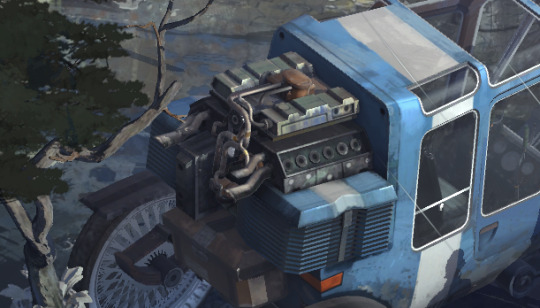
compression ignition engine: diesel, no spark plugs (diesel engines are named after a guy, rudolph diesel, so I guess in elysium they didn't do that)
rear wheel drive: this is pretty obvious just looking at the thing
100 kilometres per hour in 13.5 seconds: not very fast acceleration compared to modern cars, but the history of cars in elysium is obviously very different to irl
battery bank: this is the only thing keeping the kineema from tipping backwards onto its ass as soon as you accelerate
YOU - "What's it packing there?" (Point to the engine.) KIM KITSURAGI - "Hundred-and-thirty." INTERFACING - I reckon that's a seven-litre V12 there. ENCYCLOPEDIA - Man, that's got to be a major advancement over the KR18GU engine on the old Coupris 40. YOU - "Wait, hundred-and-thirty what?" KIM KITSURAGI - "Kilowatts," the lieutenant replies laconically.
130 kilowatts: ~174 horsepower
YOU - "That's what..." (Rub your chin.) "... a seven-litre V12?" KIM KITSURAGI - "Seven-point-two. Supercharged." The lieutenant is trying to suppress a smug smile. Unsuccessfully. EMPATHY - Saying these words brings him immense joy.
7.2 litre engine: space inside the cylinders. 7.2L/12 = 600cc per cylinder
supercharged: has a supercharger. forces more air into the engine, powered by the crankshaft (as opposed to turbochargers which are powered by the exhaust)
YOU - Run your fingers over one of the steering levers. COUPRIS KINEEMA - The white suede feels luxurious under the touch and the metal clutch handle so very familiar in your palm... INTERFACING - Your fingers waste no time closing around the handle. Clutch disengaged. Release the handle -- clutch drops -- right foot yearns for the familiar touch of the accelerator pedal. You have synced with the machine's mechanical circulation.
YOU - "A *driver* would wear down their right shoe before the left -- the accelerator is on the right. And remember that abandoned lorry cabin we found?"
steering levers: instead of a steering wheel. not exactly sure how they'd work. I *really* don't want it to have differential steering like a zero-turn mower looking at this video of kim driving it looks like the front wheels are the ones steering
clutch handle: instead of a pedal, the clutch is a handle on one of the levers. seems that accelerator and (probably) brake are still pedals
accelerator is on the right: does everyone left-foot brake??? I guess if the clutch handle is standard then that would make sense
ABANDONED LORRY - The glass on the side windows is tinted and covered with dust. You can barely make out the shape of a seat and two steering levers. [...] YOU - Check the pedals. ABANDONED LORRY - You wedge yourself under the steering-wheel to get a better look. Seems like the few tools lying around here -- a hammer, a pair of pliers, a rusty wrench -- have been casually thrown there by the disorganized driver. ABANDONED LORRY - But one odd detail does catch your eye: A piece of sandpaper has been glued to the throttle.
STEERING WHEEL TYPO
---
alright, let's actually take a look at this thing


two door: the kineema has a single driver's seat and two seats in the back. looks like you'd need to move the front seat forward to let anyone else in
suspension: the back wheels look like they have some sort of spring (the axle is connected to it, so how are the wheels being driven??? same with the coupris 40). I assume the front arms also act as a spring
rear view mirror: looks like there's no rear view mirror, since you wouldn't see shit
aerodynamics: bad
seat belts:
¯\_(ツ)_/¯
191 notes
·
View notes
Text
Lewis Nixon's Eulogy by Dick Winters
From the USAHEC archive (emphasis are mine):
I first met Lewis Nixon at Officer Candidate School, Fort Benning, Georgia, in April, 1942.
We both volunteered for the parachute troops in August, 1942 and we were both assigned to Co. E, 2nd Bn., 506th Parachute Infantry at Camp Toombs, Toccoa, Georgia.
We were together for the rest of World War II.
I have many memories of Lewis in combat.
1) On D-day I was involved in a fight to take over a battery of 105mm. cannon, firing on Utah Beach. During the battle Lewis went down Causeway #2 to the beachhead and brought back the first two tanks to come ashore at Utah Beach. He brought them to me to help finish off the battle.
From that point on, it seemed that every time I was committed to a fight, I found Nixon walking beside me.
2) In Holland, on September 17th, 1944, Operation Market Garden, right after the jump, Lewis was by my side as we approached the bridge at Son. The Germans blew the bridge and rocks and pieces of timber fell all around us.
3) On September 22, 191m, Company E was sent out as an advance party to secure Uden, a small town along Hell’s Highway.
I had only 80 men. We were cut off and surrounded. Nixon was with me.
Together, we went up a church tower for better observation of the battle. As we huddled behind the parapet, under the big church bell, a German evidently spotted us and sent a bullet to ring the bell over our heads. We literally jumped down the stairs in about two strides.
4) On September 25, 1944, the Germans cut Hell’s Highway again, this time south of Veghel. Nixon was again beside me as we crossed a big field to relieve the roadblock. In the middle of the field we came under machine gun fire from German Royal Tiger tanks and troops from the 6th German Parachute Regt.
As we hit the dirt, Nixon had a bullet hit the front of his helmet at such an angle that it just grazed his forehead, never breaking the skin, leaving only a brown mark on his forehead, before exiting through the side of his helmet.
l happened to look his way as he took off his helmet, looked at it and smiled. He refused to keep that helmet as a souvenir.
5) On October 5, 1944, in Holland, after a particularly hard fight, again, it was Nixon checking up on me to see how I was doing. It was Nixon who gave me his canteen when I asked for a drink of water - yes, the canteen was full of water - not Vat 69!
6) At Bastogne he had his name drawn out of the hat in a lottery that would have given him a 30 day leave in the States.
He refused the offer, saying he wanted to stay with the outfit on the line. How do you explain that kind of dedication? That kind of dedication is never talked about by the men, but it is never forgotten. At that time we were very short on men and officers, especially good , proven officers.
7) Nixon was moved from the 2nd Bn staff 'to the 506th Regimental staff as S-3, Plans and Training Officer. He was a key man in keeping the regiment together during the biggest battle of World War II at Bastogne.
8) On March 24, 1945, in Operation Varsity, the 17th Airborne jumped across the Rhine as the big push started to cross the Rhine River and go for Berlin. Lewis made that jump as an advisor. The plane he was in was shot down. As jumpmaster, he and three other men made it out before the plane crashed.
9) We were together every step of the way from D—Day to Berchtesgaden, May 8th, V-E Day.
Lewis Nixon was the best combat officer that I had the opportunity to work with under fire. He never at any time showed fear, and during the toughest times he could always think under fire. Very few men can think while under fire; very few men can remain poised under an artillery concentration.
Lewis always trusted me. While we were in training, before combat, Lewis hid his entire inventory of Vat 69 in my footlocker, under the tray holding my socks, beneath my underwear and sweaters. What greater trust, what greater honor could I ask for than to be trusted with his precious inventory of Vat 69?
While sharing all those days and experiences in training and in combat, we also shared our memories of our families, our school days, of our growing up, of our friends at home.
I felt as though I knew his mother, his father, his sister. I knew all about his grandparents on both sides of the family. He had a excellent heritage from both sides. He had been sent to excellent schools, and an Ivy League College. He had great wealth, was good-looking, had an excellent vocabulary, was very well-spoken; he was very well—read, smart, and had a good sense of humor. He had all the ingredients one could ask for to make a happy life - except one factor - LOVE!
Until Lewis met and married Grace he had never found or experienced true love.
It was only after his marriage to Grace that he found true happiness, peace within himself.
Together they travelled to just about every corner of the world; they shared many wonderful experiences together.
Grace demonstrated her love over these past years through her care for Lewis. Without the love and care-of Grace, Lewis would have died many, many years ago.
Whenever Grace would talk to me on the telephone, or write me a letter or a Christmas card, the message was always the same.
"Lewis is so brave; he never complains, he always has a smile for me whenever I come into his room — and that just makes it all worthwhile." I am sure those words are familiar to all of you here today.
I am also sure that all of you will agree with me when I say that with that smile Lewis gave Grace each day, it was his way of saying:
Thank you, Grace, for your care.
Thank you, Grace, for your patience in these trying times..
Thank you, Grace, for being faithful and understanding.
Thank you, Grace, for your love.
#just transcribe to text for archiving purposes#reread it and it made me sentimental again#dick winters#lewis nixon#ok so Nix brought the tanks for you not for the army#I get it#euology#listen to the soundtrack isn’t helping
50 notes
·
View notes
Note
Hello, do you have a post explaining technology in the naruto universe? It seems to be inconsistent.
It is pretty inconsistent and I think it's not used properly for the amount of technological advances they've made because in Boruto it becomes bogus. I'm gonna give you some examples but a lot of these are used 24/7 so I'm just gonna use one image.
Konoha, as well as the rest of villages (Kumogakure is said to be the most advanced technologically), have everyday life technology that we use in the real world. Pretty much everything is mechanized in Boruto's shinobi world.
1. TELEVISION AND LIVE STREAMING, AND SUBSEQUENTLY, CAMERAS:
Both Kakashi's Team 7 and Team Minato took team pictures, which means the predecessor of their modern cameras existed at least since the era of the Third Hokage, early term.
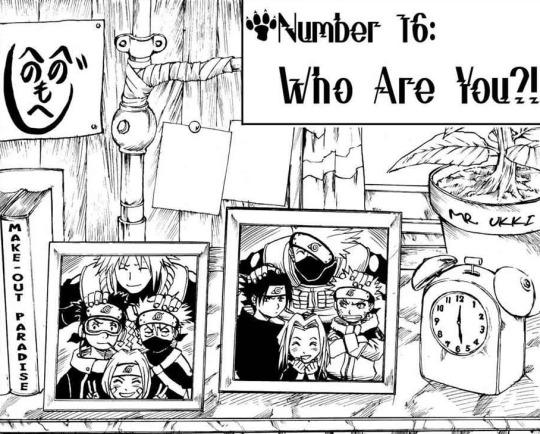
Naruto chapter 16.
They've been using television screens to broadcast live images from the Chūnin Exams back when Team 7 were genin. Gaara even looks at the television, which means there are also cameras, obviously, because they mention videotape. They also have VCR.


Naruto chapter 58.
Sasuke had a television at home, so all those interview programs that Naruto got invited too in Boruto were also a thing at least twenty years before it all. Later, everybody has a television at home, Naruto and Sakura have some more modern plasma screens.
Not to mention Konoha has screens all over their plaza in Boruto.


Naruto chapter 181 and Naruto Gaiden chapter 1.
Livestreaming wasn't just a Konoha thing, every single nation had televisions, cameras and they powered them using some special batteries as well. they also have those satellite dishes on top of buildings for broadcast.
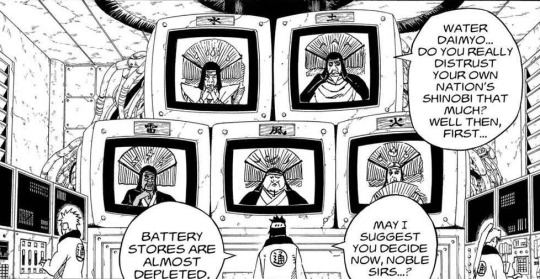

Naruto chapter 488.
The livestreaming is actually pretty useful for daimyō conferences and emergency Gokage Summits.
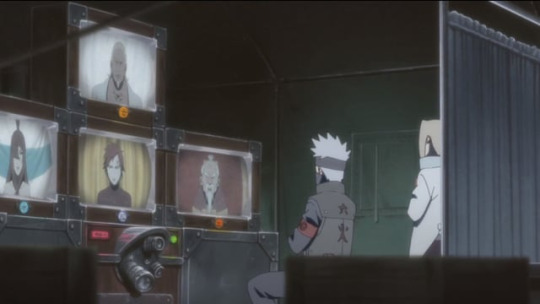

The Last: Naruto the Movie and Boruto chapter 57.
2. COMPUTERS, TABLETS AND VIDEOGAMES:
I don't think I need to delve into this one too much because it's clear that in Boruto people now work using desktop computers and laptops everyday. Naruto has a laptop, the Scientific Ninja Tools obviously have multiple computers, many of Konoha's teams and departments also use laptops, Boruto has a desktop in his room, etc.

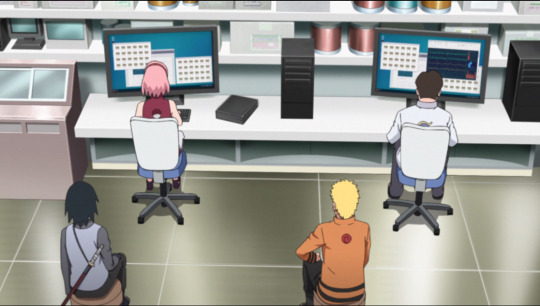
Naruto chapter 700 and Boruto episode 219.
They also have tablets and even videogame consoles have also become available in modern Konoha.
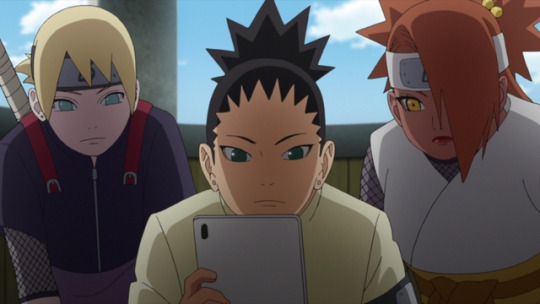
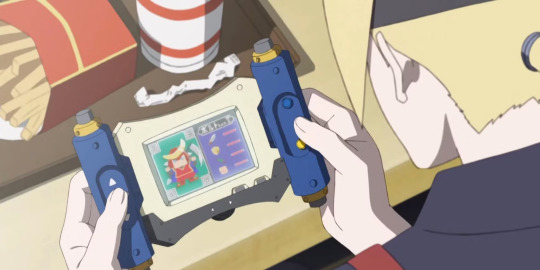
Boruto episode 211 and Boruto: Naruto the Movie.
Of course, since Naruto, there have been several machines used for health and recovery and DNA machines, etc. Or machines to facilitate mind reading as well.
3. TELEPHONES, INSTANT COMMUNICATION AND RADIO:
Phones and landlines became available after Naruto became Hokage and they're used pretty much all the time. Apparently mobile phones also exist but the information is very ambiguous because I don't recall ever seeing one, though Naruto mentions Sasuke has one depending on the translation.


Naruto Gaiden chapter 2.
Wireless radio are also very commonly used in Naruto during missions and they even evolved during the 2 year timeskip. They cover at least 1km from the shinobi's position.
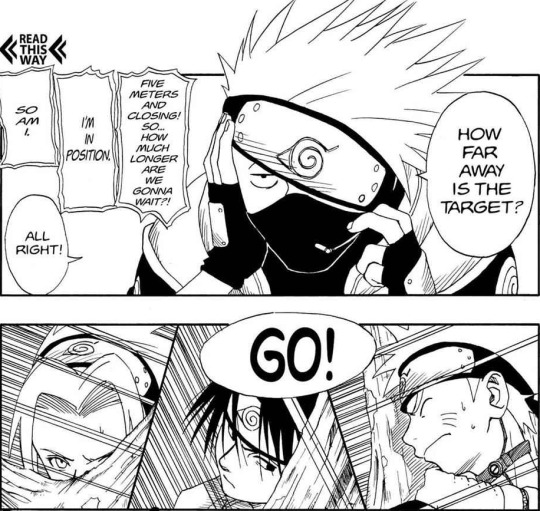

Naruto chapters 9 and 263.
They have become kinda obsolete in Boruto for no reason, but they were used at least in Boruto: Naruto the Movie and the early chapters of Boruto.
It's mentioned that it's not reliable for long distance communication, but the new device is at least covering more area since Konohamaru is somewhere in the Land of Fire talking to Konoha.
I don't recall them ever using it again, which is bogus because the new radio is very modern and small so it's easy to carry even without realizing, so I don't know why everybody in Konoha don't use it if they want to forego the landlines.
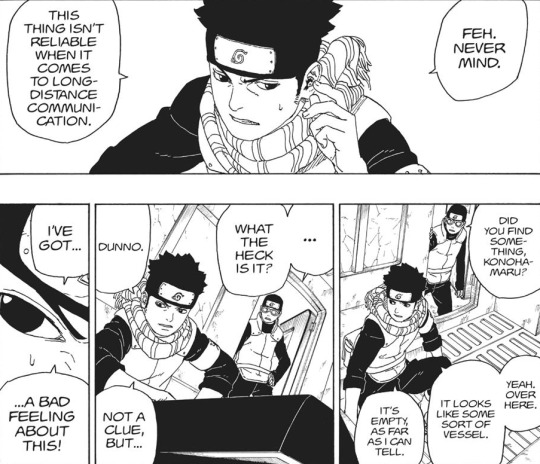
Boruto chapter 16.
Konoha, as well as the Allied Shinobi Forces, used special Chakra Communication Devices or telepathy devices for mass distance communication with machines of all sizes.
The Intelligence Division and Yin users (mental energy which is the base of mind related techniques) used it to share messages from across countries to eighty thousand shinobi, as the different divisions were scattered everywhere in the Land of Lightning and other countries.

Naruto chapter 521.
I talk more about it here since this is one of the most used technological devices in Konoha.
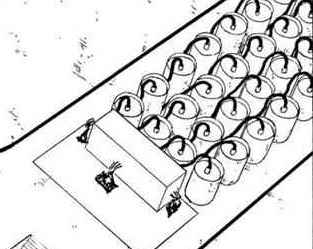

Naruto chapter 520.
Konoha also uses a more modern version of this device in their Barrier Team to notify people of intruders. They also use computers, screens and all technology mentioned above.
Similar to the wireless radios, I don't understand why Konoha hasn't made a smaller version of this for everybody to use if they want to forego telephones.


Boruto chapter 81.
Despite the technology, Sasuke still uses his hawks for example, or Naruto sends shinobi to other villages to dispatch more confidential information. Also, I'm not sure why they haven't made more practical and smaller devices for shinobi to use or why they decided to stop using some technology.
Now the shinobi gauntlet is another story because I don't understand why they're trying to sell it as some groundbreaking invention when it's just ninjutsu sealed inside scrolls. Fūinjutsu is used to seal anything, chakra, objects, ninjutsu, even life forms.
I know they are used to seal hiden jutsu as well but it's still nonsensical because Jiraiya can even seal Amaterasu inside scrolls, and Amaterasu is a Kekkei Genkai so it can't be imitated.

17 notes
·
View notes